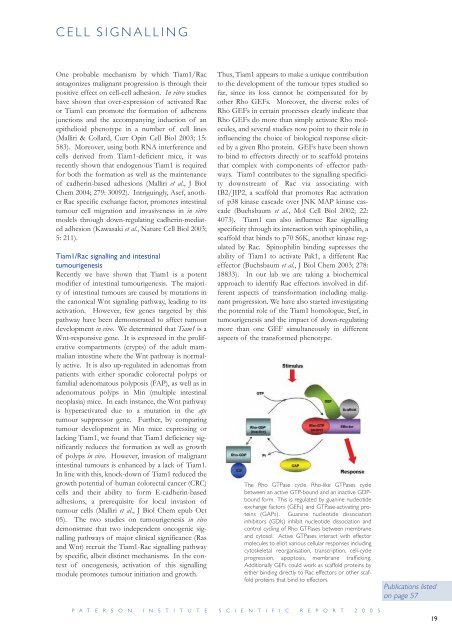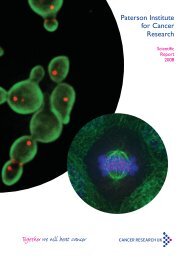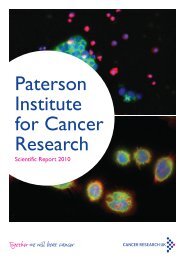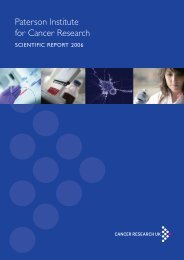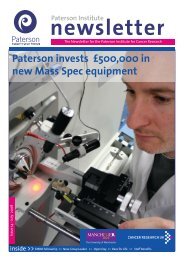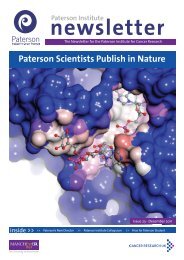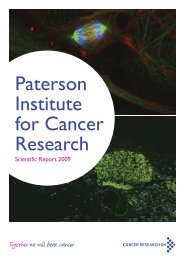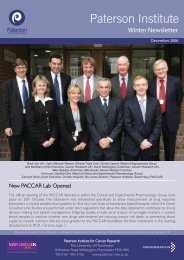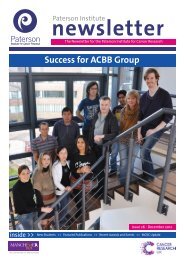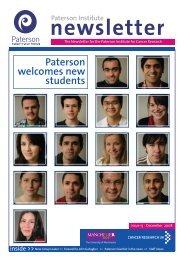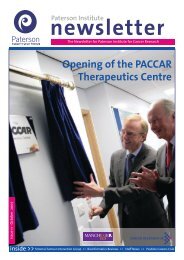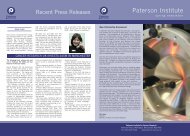Paterson Institute for Cancer Research SCIENTIFIC REPORT 2005
Paterson Institute for Cancer Research SCIENTIFIC REPORT 2005
Paterson Institute for Cancer Research SCIENTIFIC REPORT 2005
You also want an ePaper? Increase the reach of your titles
YUMPU automatically turns print PDFs into web optimized ePapers that Google loves.
CELL SIGNALLING<br />
One probable mechanism by which Tiam1/Rac<br />
antagonizes malignant progression is through their<br />
positive effect on cell-cell adhesion. In vitro studies<br />
have shown that over-expression of activated Rac<br />
or Tiam1 can promote the <strong>for</strong>mation of adherens<br />
junctions and the accompanying induction of an<br />
epithelioid phenotype in a number of cell lines<br />
(Malliri & Collard, Curr Opin Cell Biol 2003; 15:<br />
583). Moreover, using both RNA interference and<br />
cells derived from Tiam1-deficient mice, it was<br />
recently shown that endogenous Tiam1 is required<br />
<strong>for</strong> both the <strong>for</strong>mation as well as the maintenance<br />
of cadherin-based adhesions (Malliri et al., J Biol<br />
Chem 2004; 279: 30092). Intriguingly, Asef, another<br />
Rac specific exchange factor, promotes intestinal<br />
tumour cell migration and invasiveness in in vitro<br />
models through down-regulating cadherin-mediated<br />
adhesion (Kawasaki et al., Nature Cell Biol 2003;<br />
5: 211).<br />
Tiam1/Rac signalling and intestinal<br />
tumourigenesis<br />
Recently we have shown that Tiam1 is a potent<br />
modifier of intestinal tumourigenesis. The majority<br />
of intestinal tumours are caused by mutations in<br />
the canonical Wnt signaling pathway, leading to its<br />
activation. However, few genes targeted by this<br />
pathway have been demonstrated to affect tumour<br />
development in vivo. We determined that Tiam1 is a<br />
Wnt-responsive gene. It is expressed in the proliferative<br />
compartments (crypts) of the adult mammalian<br />
intestine where the Wnt pathway is normally<br />
active. It is also up-regulated in adenomas from<br />
patients with either sporadic colorectal polyps or<br />
familial adenomatous polyposis (FAP), as well as in<br />
adenomatous polyps in Min (multiple intestinal<br />
neoplasia) mice. In each instance, the Wnt pathway<br />
is hyperactivated due to a mutation in the apc<br />
tumour suppressor gene. Further, by comparing<br />
tumour development in Min mice expressing or<br />
lacking Tiam1, we found that Tiam1 deficiency significantly<br />
reduces the <strong>for</strong>mation as well as growth<br />
of polyps in vivo. However, invasion of malignant<br />
intestinal tumours is enhanced by a lack of Tiam1.<br />
In line with this, knock-down of Tiam1 reduced the<br />
growth potential of human colorectal cancer (CRC)<br />
cells and their ability to <strong>for</strong>m E-cadherin-based<br />
adhesions, a prerequisite <strong>for</strong> local invasion of<br />
tumour cells (Malliri et al., J Biol Chem epub Oct<br />
05). The two studies on tumourigenesis in vivo<br />
demonstrate that two independent oncogenic signalling<br />
pathways of major clinical significance (Ras<br />
and Wnt) recruit the Tiam1-Rac signalling pathway<br />
by specific, albeit distinct mechanisms. In the context<br />
of oncogenesis, activation of this signalling<br />
module promotes tumour initiation and growth.<br />
Thus, Tiam1 appears to make a unique contribution<br />
to the development of the tumour types studied so<br />
far, since its loss cannot be compensated <strong>for</strong> by<br />
other Rho GEFs. Moreover, the diverse roles of<br />
Rho GEFs in certain processes clearly indicate that<br />
Rho GEFs do more than simply activate Rho molecules,<br />
and several studies now point to their role in<br />
influencing the choice of biological response elicited<br />
by a given Rho protein. GEFs have been shown<br />
to bind to effectors directly or to scaffold proteins<br />
that complex with components of effector pathways.<br />
Tiam1 contributes to the signalling specificity<br />
downstream of Rac via associating with<br />
IB2/JIP2, a scaffold that promotes Rac activation<br />
of p38 kinase cascade over JNK MAP kinase cascade<br />
(Buchsbaum et al., Mol Cell Biol 2002; 22:<br />
4073). Tiam1 can also influence Rac signalling<br />
specificity through its interaction with spinophilin, a<br />
scaffold that binds to p70 S6K, another kinase regulated<br />
by Rac. Spinophilin binding supresses the<br />
ability of Tiam1 to activate Pak1, a different Rac<br />
effector (Buchsbaum et al., J Biol Chem 2003; 278:<br />
18833). In our lab we are taking a biochemical<br />
approach to identify Rac effectors involved in different<br />
aspects of trans<strong>for</strong>mation including malignant<br />
progression. We have also started investigating<br />
the potential role of the Tiam1 homologue, Stef, in<br />
tumourigenesis and the impact of down-regulating<br />
more than one GEF simultaneously in different<br />
aspects of the trans<strong>for</strong>med phenotype.<br />
The Rho GTPase cycle. Rho-like GTPases cycle<br />
between an active GTP-bound and an inactive GDPbound<br />
<strong>for</strong>m. This is regulated by guanine nucleotide<br />
exchange factors (GEFs) and GTPase-activating proteins<br />
(GAPs). Guanine nucleotide dissociation<br />
inhibitors (GDIs) inhibit nucleotide dissociation and<br />
control cycling of Rho GTPases between membrane<br />
and cytosol. Active GTPases interact with effector<br />
molecules to elicit various cellular responses including<br />
cytoskeletal reorganisation, transcription, cell-cycle<br />
progression, apoptosis, membrane trafficking.<br />
Additionally GEFs could work as scaffold proteins by<br />
either binding directly to Rac effectors or other scaffold<br />
proteins that bind to effectors.<br />
P A T E R S O N I N S T I T U T E S C I E N T I F I C R E P O R T 2 0 0 5<br />
Publications listed<br />
on page 57<br />
19


